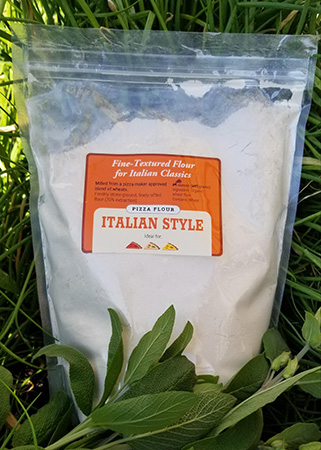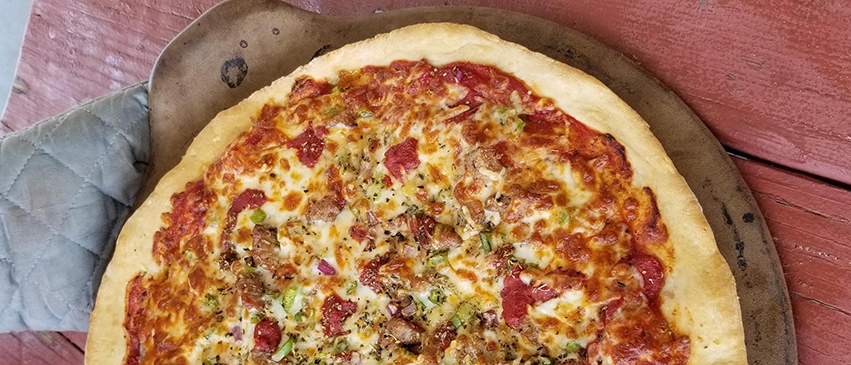You may have had difficulty finding flour at your grocery store recently, but there is no flour shortage in America. Throughout the country, small grain mills are working overtime to meet the needs of bakers while the large commodity flour businesses have struggled to meet demand. One example is Janie’s Mill in Ashkum, Illinois.
Before the COVID-19 pandemic hit Illinois, Janie’s Mill was busy delivering freshly stone-milled flour to bakeries, growing a retail market, and working with Basil’s Harvest to provide local organic oats to OSF HealthCare Saint Francis Medical Center. As commodity flour became challenging to find, head miller Jill Cummings saw her orders skyrocket—from ten orders per week to 500 orders per day. Owner Harold Wilken reports the mill has grown from three full-time employees to 23 local employees, generating jobs for the community during these tough times. According to Wilken, Janie’s Mill is seeing first-time customers enthusiastically making repeat purchases because of their high milling standards.
One of the new flours available from Janie’s Mill is a gorgeous pizza flour. Milled from a pizza-maker-approved blend of wheats, this freshly stone-ground, finely-sifted flour creates a soft crust that is the perfect base for a delicious pizza pie.
Pizza Dough
Makes two pizza crusts
 Ingredients
Ingredients
- 2 cups Janie’s Mill Pizza Flour
- 1.5 cups all-purpose flour
- 2 teaspoons salt
- 1¼ cup warm water divided (1 cup and ¼ cup)
- 2¼ tsp active dry yeast (1 0.25-oz package)
- 1 teaspoon sugar
- 1 tablespoon olive oil, plus extra for bowl
Directions: Making the Dough
- Combine pizza flour, all-purpose flour and salt in a mixing bowl.
- Mix ¼ cup of the water with yeast, sugar and oil. Let sit until yeast is dissolved, about 5 minutes.
- Add remaining water and yeast mixture to the flour mix. Combine, using your hands, to create a cohesive dough. If the dough is dry, add water, 1 tablespoon at a time. If the dough is too sticky, add all-purpose flour, 1 tablespoon at a time.
- Remove from bowl and knead until smooth, approximately 5 minutes.
- Transfer dough to an oiled bowl and cover with plastic. Place in a draft-free space until doubled in size, 1-2 hours. (In the oven, with the light on, is a perfect place.)
- Remove dough from the bowl, place on a lightly floured surface and divide into two pieces. With floured hands, reshape into two balls and place onto a lightly floured sheet pan or hard surface, seam side down. Cover with a towel and let rest about 20 to 30 minutes. (The longer it can rest, the better it will be. The dough can also be frozen or stored in the refrigerator for up to two days.)
Directions: Shaping the Pie
- Preheat oven to 500 degrees. If cooking the pizza on a stone, place the stone in the oven to preheat.
- Lightly press some of the air from dough with fingers to create a flat round; leaving some air bubbles is desirable. Approximately ¼” from the edge of the dough, form a crust by lightly pushing your fingers around the dough. This will create an indented circle, or lip, around the dough.
- Gently slide your fist under the center of the dough round and pick up half the dough, leaving the other half hanging. Gravity will start to pull the dough. Continue this process around the circle until the dough is as thin as you like it.
- Place dough onto a cookie sheet or peel if using a stone. Add desired sauces and toppings.
- Place in preheated oven. If using a stone, slide the pizza from the peel to the preheated stone. Bake for 10 minutes, rotating pie halfway through the bake.
- Remove from the oven, cut and enjoy. PM
Chef Golda Ewalt, MS, RD, CEC is director of food and nutrition services at OSF HealthCare Saint Francis Medical Center. Chef Erin Meyer, MSFS, RD is executive director of Basil’s Harvest. To purchase or learn more about the grains and flours from Janie’s Mill, check out janiesmill.com. Follow Basil’s Harvest on Instagram @basilsharvest_foodfarmhealth and Twitter @foodfarmhealth1.




